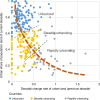Mapping global urban land for the 21st century with data-driven simulations and Shared Socioeconomic Pathways
- PMID: 32385275
- PMCID: PMC7210308
- DOI: 10.1038/s41467-020-15788-7
Mapping global urban land for the 21st century with data-driven simulations and Shared Socioeconomic Pathways
Abstract
Urban land expansion is one of the most visible, irreversible, and rapid types of land cover/land use change in contemporary human history, and is a key driver for many environmental and societal changes across scales. Yet spatial projections of how much and where it may occur are often limited to short-term futures and small geographic areas. Here we produce a first empirically-grounded set of global, spatial urban land projections over the 21st century. We use a data-science approach exploiting 15 diverse datasets, including a newly available 40-year global time series of fine-spatial-resolution remote sensing observations. We find the global total amount of urban land could increase by a factor of 1.8-5.9, and the per capita amount by a factor of 1.1-4.9, across different socioeconomic scenarios over the century. Though the fastest urban land expansion occurs in Africa and Asia, the developed world experiences a similarly large amount of new development.
Conflict of interest statement
The authors declare no competing interests.
Figures







References
-
- Angel S, Parent J, Civco DL, Blei A, Potere D. The dimensions of global urban expansion: estimates and projections for all countries, 2000–2050. Prog. Plan. 2011;75:53–107. doi: 10.1016/j.progress.2011.04.001. - DOI
-
- Seto KC, Sánchez-Rodríguez R, Fragkias M. The new geography of contemporary urbanization and the environment. Annu. Rev. Environ. Resour. 2010;35:167–194. doi: 10.1146/annurev-environ-100809-125336. - DOI
Publication types
LinkOut - more resources
Full Text Sources

